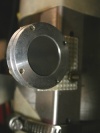ILC physics subgroup meeting
at KEK
Today's issue features a story from Keisuku Fujii, a particle physicist, who is a member of the ILC group
in KEK.

The two main pillars of the standard model. |
On May 31 we had a meeting of our ILC physics subgroup, which is a mixture of experimentalists and theorists working in Japan. The meeting was the fifth in a series that started about a year ago, and each time 20 to 30 people got together to monitor and discuss the direction of the subgroup’s activities. The primary task of the subgroup is to reexamine the ILC physics in the context of the expected LHC results and to further strengthen the physics case for the ILC project.
Read more...
-- Keisuke Fujii |
 |
|
|
 |
Upcoming meetings, conferences, workshops
European Particle Accelerator Conference (EPAC'08)
Genoa, Italy
23-27 June 2008
Joint CesrTA Kickoff Meeting and ILC Damping Rings R&D Workshop (ILCDR08)
Cornell University, USA
8-11 July 2008 34th International Conference on High Energy Physics (ICHEP'08)
Philadelphia, USA
29 July - 5 August 2008
Conference on the Design/ Optimization of the Silicon Detector at the International Linear Collider
University of Colorado at Boulder, Colorado, USA
17-19 September 2008
Upcoming schools
The second Trans-European School for High Energy Physics (TES-HEP)
Buymerhovka, Sumy region, Ukraine
3-9 July 2008
Third International Accelerator School for Linear Colliders (2008 LC School)
Oak Brook, Illinois, USA
19-29 October 2008
|
|
 = Collaboration-wide Meetings = Collaboration-wide Meetings
GDE Meetings calendar
View complete ILC calendar
|
|
|
 |
Second sound sounds promising
Cornell proposes new cavity temperature mapping technique

Is it a microphone? Is it a thermometer? It's an oscillating superleak transducer! |
“Our superconducting technology group here at Cornell is doing some very fundamental R&D,” says Hasan Padamsee, physics professor at Cornell university and expert in superconducting rf technology. “Note that the stress is on the fun in fundamentals.” Students are even allowed to drill holes into cavity prototypes in order to find out what makes certain areas in the material behave differently from others. A new mapping technique, invented by Cornell's Don Hartill, Zach Conway and Eric Smith, could make it possible to locate quenches during cavity tests with just eight (instead of up to 180) thermometers.
Read more...
-- Barbara Warmbein |
 |
|
|
 |
From Physics World
18 June 2008
No extra cash for UK physics
Any remaining hopes that the UK government might plug an £80m hole in the nation's physics-research budget were dashed yesterday.
Read more... |
|
From France Inter
17 June 2008
La "tête au carré”, a France Inter radio programme devoted to science, set up its sound booth at CERN for a special broadcast on the LHC. Guest are 3 physicists, a theorist and an experimentalist from CNRS-IN2P3, France and an accelerator experimentalist from CERN.
Listen to the broadcast here (in French)
Read more... |
|
|
 |
Integrating ideas at Dubna

Marc Ross preparing his summary talk in Russian early on Friday |
At the recent Conventional Facilities and Siting Workshop in Dubna, there were four focus groups: Shallow Site, Infrastructure, Siting and Accelerator Systems. However before the meetings formally began, the conveners of the latter two had integrated them into one. These conveners, Nikolai Solyak, Andrei Seryi, Masao Kuriki and myself, felt that the subjects had so much overlap and were so strongly coupled that it would be more productive for the parties involved to discuss them together.
Read more...
-- Ewan Paterson
Director's Corner Archive |
|
EUROTeV Reports
02008-020
Collimator R&D
02007-046
Precision Beam Position Monitor for EUROTeV
|
|

